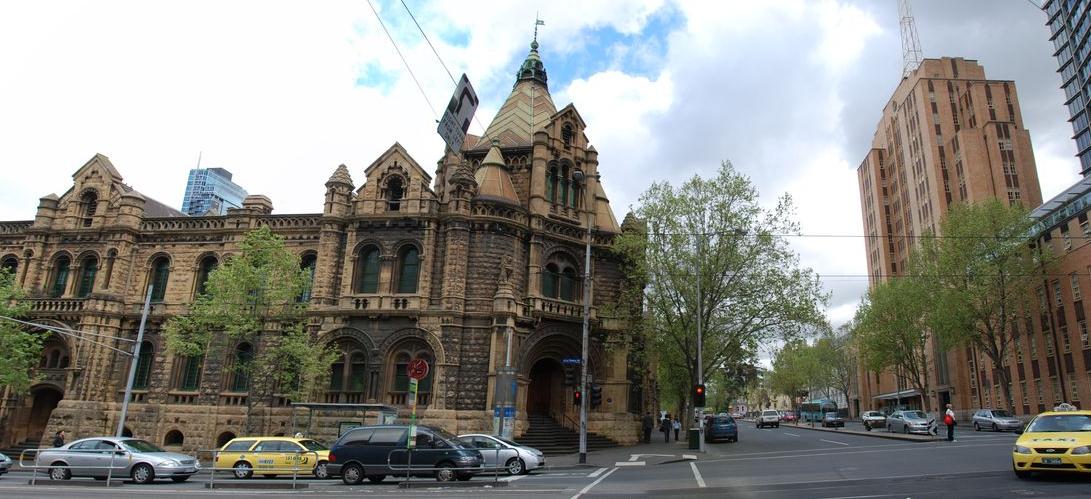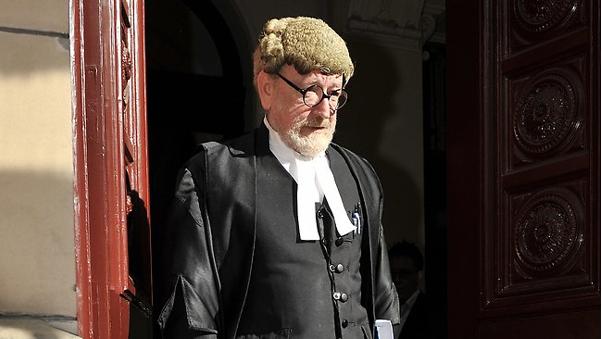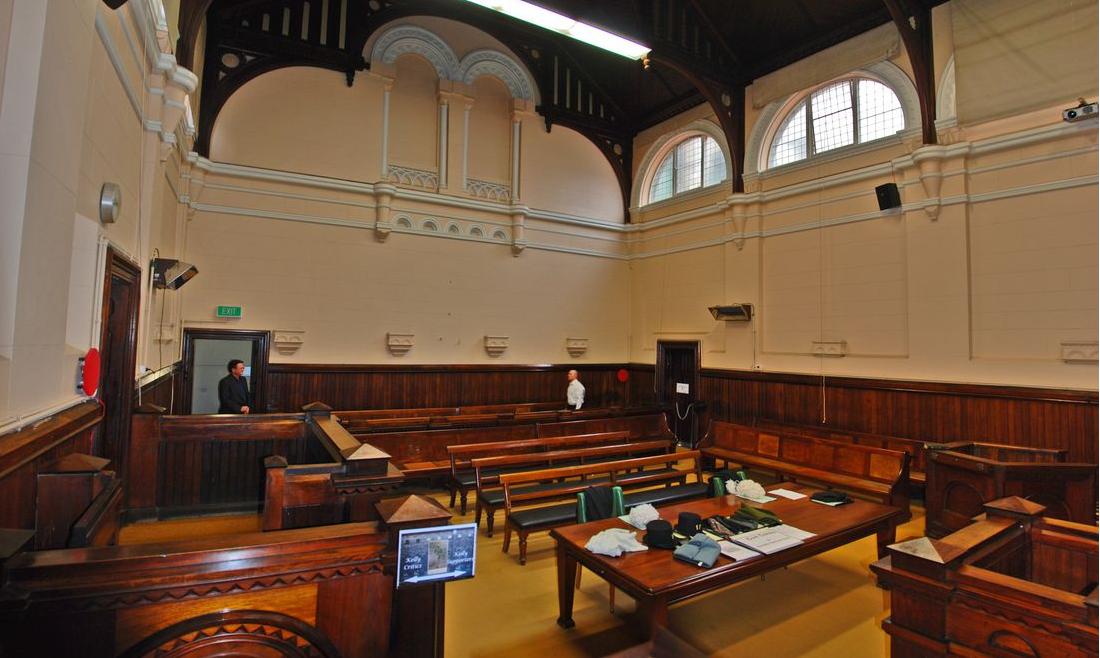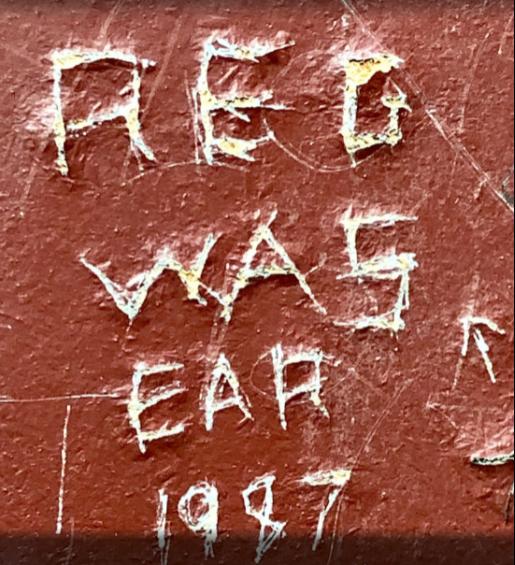The main judicial hearings resulting from the Hoddle Street Shootings and the quick containment then arrest by local police of Julian Knight that night were as follows:
Murder Charge
The day after the Hoddle Street Shootings, on Monday 10th August 1987, Julian Knight was transferred from a standard cell the Melbourne City Watch-House on Russell Street via a secure underground corridor to the then Melbourne Magistrates Court next door situated on the corner of Russell and LaTrobe Streets.
Knight appeared before Chief Magistrate John “Darcy” Dugan at 12.20pm in Court 1 of the Melbourne Magistrates’ Court. At this ‘First Mention‘ (of a case) hearing Knight was initially charged with the murder of one of the Hoddle Street victims, John Muscat, based upon on the information of Detective Senior Sergeant Brian McCarthy.
Knight was then remanded in custody H.M Pentridge Prison in Coburg to appear again for a Remand Hearing in the Melbourne Magistrates’ Court set for a week’s time scheduled for 17th August 1987.
Committal Proceedings

Some eight months later on Monday the 18th April 1988, Julian Knight appeared before Chief Magistrate Dugan between 11.05am-12pm in Court 3 of the Melbourne Magistrates’ Court.
This hearing constituted the committal proceedings against Knight, with barrister Mr John “Joe” Dickson QC and junior barrister Mr Julian Leckie representing the Department of Public Prosecutions, and with barrister Mr Robert Richter QC (below), junior barrister Mr Richard Pirrie and Legal Aid Commission of Victoria solicitor Mr Michael “Mick” O’Brien representing Knight.

No witnesses were called, although brief statements were made by Dickson and Richter, and the hearing was adjourned until the following morning.
The following day, Tuesday the 19th April 1988, Julian Knight appeared again before Chief Magistrate Dugan between 10.07am-10.15am on in Court 3 of the Melbourne Magistrates’ Court.
This hearing constituted the final part of the committal proceedings against Knight. At this hearing Knight was committed by Chief Magistrate Dugan to stand trial on 7 counts of murder, 39 counts of attempted murder, seven counts of intentionally cause serious injury and twelve counts of intentionally cause injury, in the Supreme Court of Victoria at Melbourne during the sessions to be commenced on the 6th June 1988, two month’s away to allow time for the parties to prepared their cases.
Hoddle Street Shootings Inquest
On Thursday the 2nd June 1988, Knight appeared before Victorian State Coroner Harold Hallenstein between 10am-10.55am in the Melbourne Coroner’s Court.

This hearing constituted the inquest into the 7 Hoddle Street deaths with barrister Mr Joe Dickson QC and junior barrister Mr Julian Leckie assisting the Coroner, and with junior barrister Mr Richard Pirrie representing Knight. Knight made no plea at this hearing. The hearing was one of the shortest inquests in Australian legal history.
Only one witness was called to give evidence, newly promoted Detective Sergeant Graham Kent, who read a brief statement based on Dickson’s statement at the committal, following which Coroner Hallenstein found that Knight caused the death of the seven Hoddle Street victims.
[Ref: Victorian State Coroner’s File Nos:
- John Peter Muscat 3436/87
- Tracey Marie Skinner 3438/87
- Kenneth Shane Stanton 3440/87
- Robert George Mitchell 3441/87
- Vesna Markovska 3442/87
- Dusan Flajnik 3443/87
- Georgina Papaioannou 3622/87].
Knight’s Inquest Application
On Wednesday 19th October 1988, Knight appeared before Mr Justice George Hampel between 10.30am-11am, 12pm-12.40pm and again 2pm-2.20pm in Court 3 of the Supreme Court of Victoria at Melbourne. This hearing was to hear an application by Knight for an order directing the Victorian State Coroner to re-open the inquest into the 7 Hoddle Street deaths, pursuant to section 59(3)(a) of the Coroners Act 1985 (Vic) [Application No: M354/1988].
At this hearing barrister Mr Peter J. Bick represented the Coroner and the Victorian Attorney-General, and Knight represented himself. [Julian could not afford a solicitor nor barrister to represent him and Julian’s all but estranged step-father was not funding Julian’s legal defence in any way]. Following submissions from Bick and Knight, Mr Justice Hampel dismissed Knight’s application.
R v Knight (1988) 35 A Crim R 314 [Case T557]
[In Julian Knight’s own words]:
“As part of their investigation into my background, Victoria Police obtained statements from my ICT instructor, Sergeant Kim HOGAN, and from a 3rd Class cadet in my section, Staff Cadet Christopher WHITTING (CSC No 5336).
As part of the preparation of my defence, the Legal Aid Commission of Victoria used a private investigator to obtain statements about my time [at RMC Duntroon Jan-June 1987] in Canberra from [Duntroon junior Officer Staff Cadets] Meg RUMMERY, Liz GLOVER, and Staff Cadet Christopher WHITTING and from ADFA Officer Cadet Dechlan ELLIS.
On 6 June 1988, the Presentment against me was filed in the Supreme Court of Victoria at Melbourne (Case No T557 of 1988). I was formally charged with 7 counts of murder and 46 counts of attempted murder.
In early October 1988, following negotiations with the Office of Public Prosecutions, it was decided that I would plead guilty to all charges in the Presentment filed against me (7x counts of murder and 46 counts of attempted murder).”
[Duntroon’s Plea Bargain Deal with Knight]
“It is my understanding that these negotiations involved input from the Army. Part of my plea agreement with the Crown and their main condition was that no evidence of the bastardization I had experienced at Duntroon would be led during my plea hearing.
In return, the Crown undertook that it would not oppose the setting of a minimum term to the Life sentences I was certain to receive.
It was made clear by the Crown that if we went back on this agreement, by raising the issue of bastardization at Duntroon, the Crown would renege on its promise not to oppose the setting of a minimum term and would treat the plea hearing as a contested proceeding.”
[Knight’s record of his Plea Hearing]:
“On 28 and 31 October 1988, my plea hearing was held in the Supreme Court of Victoria at Melbourne before the Honourable Justice George HAMPEL.
The Crown was represented by Senior Crown Prosecutor John “Joe” DICKSON QC, with Julian LECKIE as junior counsel, instructed by Peter BUCKLEY, Solicitor to the Director of Public Prosecutions (“DPP”).
My defence was conducted by Robert RICHTER QC, with Richard PIRRIE as junior counsel, instructed by Michael “Mick” O’BRIEN, the then Associate Director of the Criminal Law Division of the Legal Aid Commission of Victoria.
My plea hearing was attended by the CO of the CSC, Lieutenant-Colonel David KIBBEY, and an Army legal officer. Both were dressed in civilian attire, sat with the Crown prosecutors and did not approach or speak to me.
My time at Duntroon was addressed briefly during the first day of my plea hearing (Ref: R -v-Knight, Supreme Court of Victoria, transcript, Friday 28 October 1988, pages 20-23. (See Attachment 8), but no acts of bastardization were detailed. The bastardization I was subjected to at Duntroon was, however, detailed in the report of forensic psychiatrist Dr David SIME tendered to the Court. I have attached extracts from the conclusion section of Dr SIME’s report (Attachment 7), and that from the report prepared by forensic psychologist Tim WATSON-MUNRO (Attachment 6).”
[Refer to the webpage on this website https://julianknight.com.au/imprisonment/state-of-mind-evidence/]
[Knight’s record of his Sentencing]:
On 10 November 1988, I was sentenced by the Honourable Justice HAMPEL in the Supreme Court of Victoria to life imprisonment with a minimum non-parole term of 27 years (Ref: R -v-Knight [1989] VR 705, www.lexis.com (research Ref: 1988 VIC LEXIS 530).
In sentencing me His Honour said (at 706):
In 1986 you joined the Army Reserve and later that year were accepted at Duntroon Military College where you commenced as a Cadet in January 1987. Your father was a career army officer. Although your parents separated when you were about twelve and you felt rejected by your father, nevertheless you admired him and wanted to be like him. You have always wanted to be a soldier and getting into Duntroon was the ultimate achievement for you. In fact your time there turned out to be one of a series of events which, according to the evidence of the experts, contributed to your final inability to cope.
You did not do well at Duntroon and could not cope with the pressures of life and discipline at such an institution. Your perception was that you were ill-treated and dealt with unjustly. You clashed with your superiors and ultimately, as a result of an incident in which you stabbed a sergeant with a pocket knife, you had to leave Duntroon and return to Melbourne in early July 1987.
My earliest eligibility date (EED) for release on parole is 8 May 2014.”
SOURCE: Julian Knight’s ‘Personal Account’ (97-pages) of his 6-month relentless persecution at RMC Duntroon submitted to the Defence Abuse Response Taskforce (DART) dated 26 November 2013, pp. 89-91].


References:
[1] ‘Julian Knight – The Hoddle St Massacre‘, website, http://www.julianknight-hoddlestreet.ca/ (Canada), (website defunct since May 2017)
[2] Julian Knight’s ‘Personal Account’ (97-pages) of his 6-month relentless persecution at RMC Duntroon submitted to the Defence Abuse Response Taskforce (DART) dated 26 November 2013, pp. 89-91].
